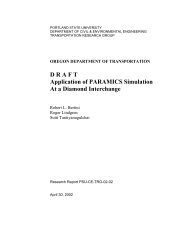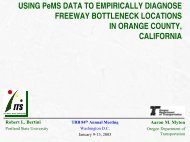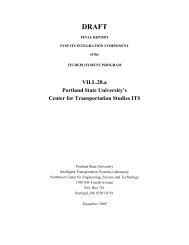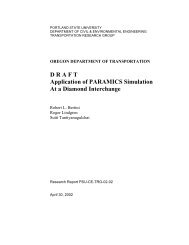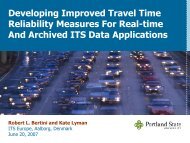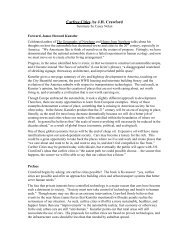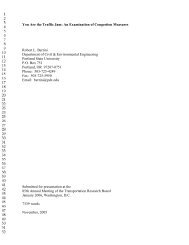Generating Transit Performance Measures with ... - Transportation
Generating Transit Performance Measures with ... - Transportation
Generating Transit Performance Measures with ... - Transportation
You also want an ePaper? Increase the reach of your titles
YUMPU automatically turns print PDFs into web optimized ePapers that Google loves.
Bertini and El-Geneidy Paper No. 03- 4393 113<br />
TABLE 2 Daily Report for Route 14<br />
Inbound Outbound Total<br />
Hours Minutes Seconds Hours Minutes Seconds Hours Minutes Seconds<br />
Hours of service 77 37 48 71 15 40 148 53 28<br />
Scheduled hours of service 72 18 0 71 55 0 144 13 0<br />
Number of scheduled trips 105 107 212<br />
Number of actual trips 103 104 207<br />
Number of scheduled miles 814.8 862.4 1,677.2<br />
Number of actual miles operated 843.6 806.8 1,650.3<br />
Number of passengers carried 3,772 4,165 7,937<br />
Total boardings and alightings 7,544 8,331 15,875<br />
Average passenger load during the trip 73.2 80.1 116.7<br />
Number of passengers per mile 8.9 10.3 14.8<br />
Average scheduled speed mile/hour 11.3 12.0 11.7<br />
Average speed mile/hour 10.9 11.3 11.1<br />
Number of operators 46 24 70<br />
• Average scheduled speed (mi/h),<br />
• Average speed (mi/h), and<br />
• Number of operators.<br />
These data can also be compared for peak periods only, and from<br />
day to day, and, if archived systematically, they can be compared<br />
longitudinally over many years. As shown in Table 2, on Route 14<br />
there were 103 inbound trips per day, and the average delay was<br />
3 min per trip which resulted in total delay of approximately 5 h and<br />
19 min. At the system level, TriMet operates approximately 98<br />
routes in the Portland metropolitan area. A total of daily 531 h of<br />
lost time can be extrapolated from the data from the single route.<br />
Table 3 shows a sample of a peak period analysis for Route 12,<br />
indicating the following variables:<br />
• Actual trip time,<br />
• Scheduled trip time,<br />
• Actual layover time,<br />
• Total dwell time,<br />
• Total passenger boardings,<br />
• Total passenger alightings, and<br />
• Total number of trips.<br />
Dwell time is another measure that can be analyzed at the system,<br />
route, or point level. Table 4 shows an example of route-level analysis<br />
of dwell time for Route 12 over 3 consecutive days, using the<br />
following measures:<br />
• Total number of stops,<br />
• Total dwell time and layovers,<br />
• Total dwell time <strong>with</strong>out layovers,<br />
• Total layover time,<br />
• Total number of dwells and layovers,<br />
• Total number of dwells <strong>with</strong>out layovers,<br />
• Average dwell time,<br />
• Total number of passengers served,<br />
• Total number of passenger boardings,<br />
• Total number of passenger alightings,<br />
• Total number of lift use,<br />
• Total dwell time <strong>with</strong> lift used,<br />
• Total number of dwells <strong>with</strong> passenger movement,<br />
TABLE 3 Peak Period Analysis for Route 12<br />
Inbound trips a.m. peak<br />
Outbound trips p.m.<br />
peak<br />
<strong>Measures</strong> Hours Minutes Seconds<br />
Actual trip time 14 47 46<br />
Scheduled trip time 14 59 0<br />
Actual layover 3 10 12<br />
Total dwell time 1 55 24<br />
Total passenger boardings 747<br />
Total passenger alightings 471<br />
Total number of trips 18<br />
Actual trip time 17 28 10<br />
Scheduled trip time 16 15 0<br />
Actual layover 0 24 14<br />
Total dwell time 4 2 28<br />
Total passenger boardings 712<br />
Total passenger alightings 973<br />
Total number of trips 16



